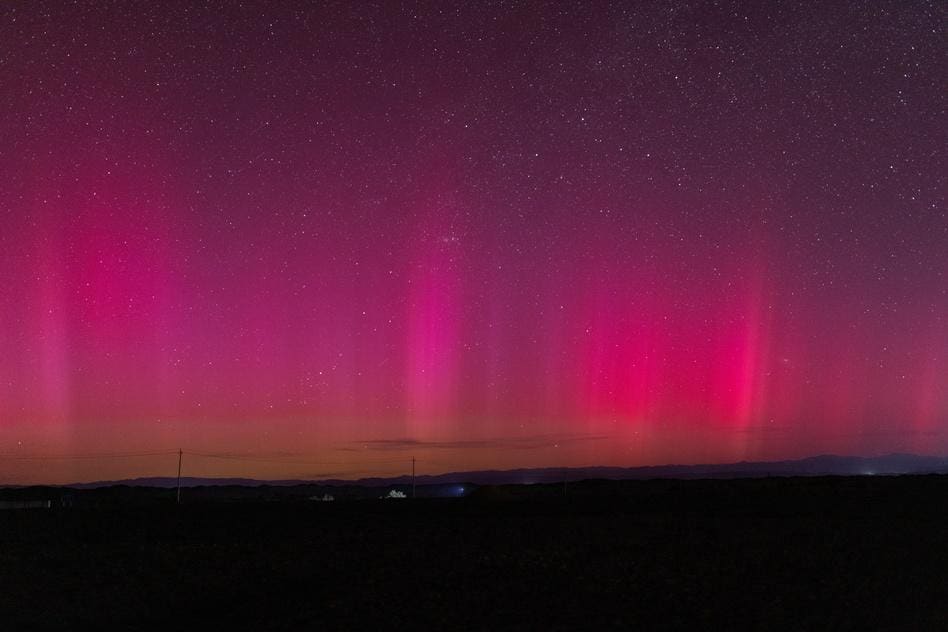Latest Northern Lights Forecast: Where To See The Northern Lights Tonight—Possibly The Last Time This Week
Topline
This week’s geomagnetic storm watch ends Thursday, so it may be the last night aurora chasers can view the Northern Lights this week, though scientists say the aurora will be more active as the sun goes through its latest solar cycle and reaches its peak sometime between late 2024 and 2026.
The aurora borealis glows in the night sky.
Key Facts
Thursday night’s aurora has a Kp index of four, meaning the lights will move further from the poles and appear brighter to observers, causing them to be “pleasing to look at” under the correct viewing conditions, according to the National Oceanic and Atmospheric Association.
This comes after coronal mass ejections (CMEs)—eruptions of solar material—that were released over the weekend arrived to Earth Tuesday and Wednesday, causing light shows across many continental U.S. states.
A “Cannibal CME,” which happens when two CMEs combine to form a massive CME that causes strong aurora displays, reached Earth Tuesday, and was accompanied by a train of smaller CMEs that arrived to Earth Wednesday.
NOAA issued geomagnetic storm watches starting Monday that originally ended Wednesday night, but have now been extended to Thursday, and forecasters expect another CME to reach Earth Thursday and cause a moderate G2 geomagnetic storm, or a minor G1 geomagnetic storm, according to Spaceweather.com, a database ran by astronomer Tony Philips.
Where Will The Northern Lights Be Visible Tonight?
Though it’s difficult to predict where exactly the lights will be visible, NOAA offers a forecast with a potential viewline (see below). U.S. states within the aurora’s view line include Alaska, Washington, Oregon, Idaho, Montana, Wyoming, North Dakota, South Dakota, Minnesota, Wisconsin, Michigan, New York and Maine.
Thursday night’s aurora view line.
What’s The Best Way To See The Northern Lights?
The lights are usually most active between 10 p.m. and 2 a.m. EDT. For the best views of the Northern Lights, the agency advises traveling as close to the poles as possible, avoiding city lights and other light pollution, monitoring weather forecasts for prime viewing conditions and finding a position on a vantage point like a hilltop. Smoky skies due to wildfires in Canada and California may affect the views of some aurora chasers in the northern U.S.
What’s The Best Way To Photograph The Northern Lights?
Smartphone cameras are sensitive enough to pick up the aurora, even when it’s invisible to the naked eye. Visit Iceland, a tourist website for Iceland, where the lights are often visible, advises turning on night mode to best increase smartphone camera exposure.
Key Background
Very active sunspots NOAA dubbed as NOAA Active Region 13664 are the cause of the Northern Lights that have been popping up in the U.S. since May. These sunspots caused a G5 geomagnetic storm—which is the highest label storms can have—in May, leading to the strongest storm since the Halloween solar storms of 2003. Researchers believe a Cannibal CME was also the culprit behind May’s dazzling lights. A celestial event called Solar Cycle 25—the cycle the sun goes through around every 11 years—has been the cause of geomagnetic storms that have resulted in recent sightings of the Northern Lights. It began in 2019, and it’s estimated it will reach its peak—when solar activity will reach its maximum—between late 2024 and early 2026. It’s estimated it will peak with 115 sunspots, which are where geomagnetic storms originate. Although the maximum hasn’t happened yet, the sun’s activity has been busier than scientists anticipated, so it’s possible there will be even more geomagnetic storms leading up to the peak, though it’s difficult to predict exactly when these storms will occur.








